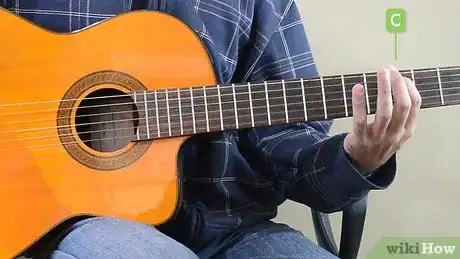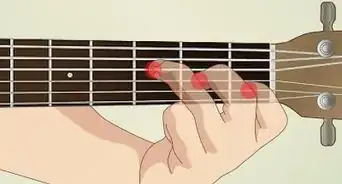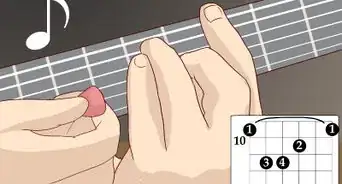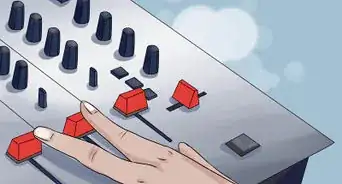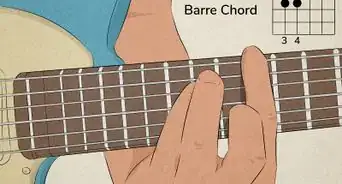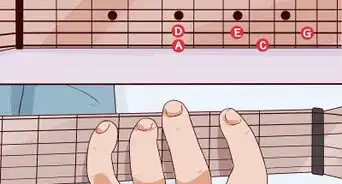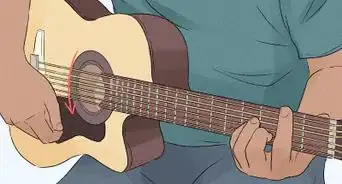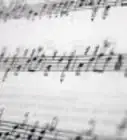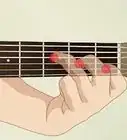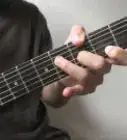This article was co-authored by Aaron Asghari and by wikiHow staff writer, Jennifer Mueller, JD. Aaron Asghari is a Professional Guitarist and the lead guitarist of The Ghost Next Door. He received his degree in Guitar Performance from the Guitar Institute of Technology program in Los Angeles. In addition to writing and performing with The Ghost Next Door, he is the founder and primary guitar instructor of Asghari Guitar Lessons.
This article has been viewed 103,270 times.
The C Major scale is a good place to start when you are learning to play guitar. Unlike some other scales, the C Major scale has no sharps or flats. There are three basic ways to learn how to play any scale on guitar: by note, by interval, or by pattern. There is no right or wrong way to learn. Play around with the different methods and find the way that "clicks" for you.[1]
Steps
Learning the Scale by Note
-
1Find the root note of the scale. The root note of any scale is the note that gives the scale its name. Therefore, the root note of the C Major scale is a C. The root note also is the lowest note on the scale.[2]
- You can find C on the third fret of the fifth string of your guitar. Fret the string with your index finger. Just use your fingertip so the string sounds cleanly and you don't mute any of the other strings. Keep the rest of your fingers curled over the keys. Think of making the shape of a "C" with your fingers around the fret board.
- Scales repeat through octaves, so the scale naturally progresses back to the root note, which will then be one octave higher.
-
2Memorize the notes in the C Major scale. The notes of the C Major scale are C-D-E-F-G-A-B. These notes remain the same regardless of the octave.[3]
- If you find it easier to play by ear with reference notes, find an audio recording of the C Major scale online and listen to it. Sing along with the names of the notes until you have the notes memorized. Then try to find those notes on your guitar.
Advertisement -
3Use the corresponding finger on the corresponding fret. When you learn to play guitar, your fingers are numbered in a universal way. The frets on your guitar also are numbered. In first position, the finger number and the fret number are the same, so that your first finger is on the first fret.[4]
- In case you aren't familiar, your first finger is your index finger, your second finger is your middle finger, your third finger is your ring finger, and your fourth finger is your pinky.
- After first position, the relations between finger numbers and fret numbers change. For example, if your first finger is on the second fret, your hand is in second position. The second finger has access to the third fret, your third finger to the fourth fret, and so on.
- Remember to use just the tip of your finger to fret the strings, and keep your other fingers curled over the fret board when you're not using them to fret a string.
-
4Say or sing the name of the note as you play the scale. When you first play the C Major scale, do it slowly. Saying or singing each note aloud as you play will help reinforce the names of the notes in your head.[5]
- If you can sing the note (in tune), this will help you associate the name of the note with a particular sound. When you hear that sound in a different octave, you will automatically know what note it is.
-
5Sound out a melody with the notes. Once you've learned the notes to the C Major scale, play around with the notes. You'll discover simple melodies that can be played simply with the notes from the C Major scale.[6]
- For example, you can play the song "Twinkle, Twinkle Little Star" using only the notes from the C Major scale. In fact, this song can be played entirely on one string on your guitar.
- Practicing simple songs like this is a good way to become familiar with the scale itself and the relations between the notes.
Learning the Scale by Interval
-
1Memorize the interval formula for major scales. All major scales are formed using the same interval formula. Once you've memorized this formula, you can not only figure out how to play the C Major scale, you can learn any other major scale by applying the formula.[7]
- Intervals are specified by whole and half steps. On your guitar, a whole step is two frets, while a half step is one fret.
- For all major scales, there is a whole step between the first and second notes, a whole step between the second and third notes, and a half step between the third and fourth notes. Then you have whole steps between the rest of the notes up until the seventh note. There is a half step between the seventh and eighth notes. This interval formula can be abbreviated W-W-H-W-W-W-H.
-
2Find the root note. The root note of any scale is the note that names the scale. So for the C Major scale, the root note is C. In first position, you'll find this note on the third fret of the fifth string.[8]
-
3Move up one whole step from the root note. On your guitar neck, one whole step equates to two frets. So if you started on the third fret of the fifth string, the second note in the C major scale would be on the fifth fret of the fifth string.[9]
-
4Follow the formula to map the scale. Using the interval formula, you can accurately play the C Major scale on any given string, starting from the root note. A whole step up from C is D, another whole step up is E, a half step to F, and so on.[10]
- Sing the names of the notes along with your playing to connect the notes to the intervals.
-
5Practice playing the scale on one string. Every major scale can be played on each individual string. When learning the scale by interval, this is one of the easiest ways to understand the relation between the notes and prepare you to move up and down the neck with a scale.[11]
- While normally you will play a scale across several strings, moving up and down a single string can help you understand the logic of how notes are arranged in scales and octaves. Try this if you are a beginning guitarist – the understanding will help you pick up more complex melodies later.
- When you're playing the entire scale on one string, you also can simply move one finger up and down the fret board, rather than worrying about changing fingers. This will help you become more familiar with moving around on the neck of your guitar.
Learning the Scale by Pattern
-
1Start with chords that you know. If you already know a few chords on guitar, it may be easier for you to learn scales by pattern than by note or interval. When you play a chord on guitar, you're playing every other note of the scale starting with the root note, which gives the chord its name.[12]
- When you find chords within scales, you can blend the two together to improvise sequences on your guitar.
- If you know the root note of a chord, you can figure out the scale for that note from the chord alone, especially if you've already learned the interval formula.
-
2Study pattern diagrams. You can find pattern diagrams online or in books on how to play guitar. By memorizing these diagrams, or finger shapes, you can easily play a number of different scales and chords up and down the neck of your guitar.[13]
- Pattern diagrams may be the easiest way for you to learn if you are a visual learner. Finding patterns also can be more fun than memorizing notes or following an interval formula.
- The pattern diagrams show you where to place your fingers when you're playing a chord. Typically the root note is a black dot and the other notes are blank dots. You also might see finger numbers or notes. Use the type that's easiest for you to understand.
-
3Link together single-octave patterns to make multi-octave patterns. Once you've become familiar with the single-octave patterns for the C Major scale, you can create larger patterns that cover the whole fretboard and encompass multiple octaves.[14]
- Remember that notes repeat as you move up the fretboard. If you fret a string at the first fret, you'll find the same note by fretting that string at the thirteenth fret – just in a different octave.
- Single-octave patterns repeat up and down the fretboard, so once you've learned it in one position, move down to the next root note and play it again in a different octave.
Expert Q&A
-
QuestionHow do you combine scales?
 Aaron AsghariAaron Asghari is a Professional Guitarist and the lead guitarist of The Ghost Next Door. He received his degree in Guitar Performance from the Guitar Institute of Technology program in Los Angeles. In addition to writing and performing with The Ghost Next Door, he is the founder and primary guitar instructor of Asghari Guitar Lessons.
Aaron AsghariAaron Asghari is a Professional Guitarist and the lead guitarist of The Ghost Next Door. He received his degree in Guitar Performance from the Guitar Institute of Technology program in Los Angeles. In addition to writing and performing with The Ghost Next Door, he is the founder and primary guitar instructor of Asghari Guitar Lessons.
Professional Guitarist & Instructor Start at the 3rd fret of the A string, then the 5th of the A string, followed by the 2nd, 3rd, and 5th frets on the D string, and finally the 2nd, 4th, and 5th frets on the G string.
Start at the 3rd fret of the A string, then the 5th of the A string, followed by the 2nd, 3rd, and 5th frets on the D string, and finally the 2nd, 4th, and 5th frets on the G string. -
QuestionWhat string do I play?
 Community AnswerYou can play the whole scale on one string, or play it on 2 - 4 strings. The best is to play it either on the 6th, 5th and 4th; or 5th, 4th and 3rd. If you prefer the first option, then you have to play frets 8/10/ 12 on the 6th string, again 8/10/12 on 5th string and 9/10 on 4th string. If you prefer starting from the 5th string, play 3/5/7 on the 5th, again 3/5/7 on the 4th, and 6/7 on the 3rd.
Community AnswerYou can play the whole scale on one string, or play it on 2 - 4 strings. The best is to play it either on the 6th, 5th and 4th; or 5th, 4th and 3rd. If you prefer the first option, then you have to play frets 8/10/ 12 on the 6th string, again 8/10/12 on 5th string and 9/10 on 4th string. If you prefer starting from the 5th string, play 3/5/7 on the 5th, again 3/5/7 on the 4th, and 6/7 on the 3rd. -
QuestionWhat does a sharp behind a G mean (G#) when the scale is C major (A minor)?
 Community AnswerIt means that the note is sharp, which is 1 fret above your G note. The G# isn't in the key of C Major; although, in this key, it is considered as chromatic.
Community AnswerIt means that the note is sharp, which is 1 fret above your G note. The G# isn't in the key of C Major; although, in this key, it is considered as chromatic.
References
- ↑ https://www.classicalguitarcorner.com/l105-scale-in-c-major/
- ↑ https://www.guitarlessonworld.com/lessons/major-scale/
- ↑ https://www.guitarlessonworld.com/lessons/major-scale/
- ↑ https://www.classicalguitarcorner.com/l105-scale-in-c-major/
- ↑ https://www.classicalguitarcorner.com/l105-scale-in-c-major/
- ↑ http://hubguitar.com/ear-training/play-melodies-by-ear
- ↑ https://www.guitarlessonworld.com/lessons/major-scale/
- ↑ http://acousticguitar.com/play-leads-with-major-scales/
- ↑ http://acousticguitar.com/play-leads-with-major-scales/
- ↑ http://acousticguitar.com/play-leads-with-major-scales/
- ↑ https://www.guitarlessonworld.com/lessons/major-scale/
- ↑ https://www.guitarlessonworld.com/lessons/major-scale/
- ↑ https://www.guitarlessonworld.com/lessons/major-scale/
- ↑ https://www.guitarlessonworld.com/lessons/major-scale/
- ↑ https://www.classicalguitarcorner.com/l105-scale-in-c-major/
- ↑ http://www.guitarfriendly.net/guitar-scales-lesson-for-beginners-major-guitar-scales/
